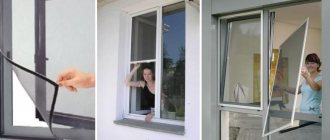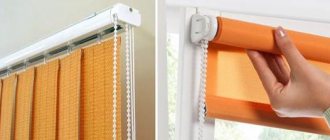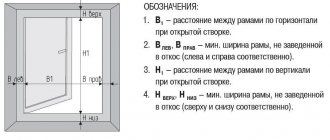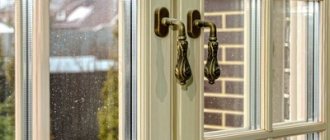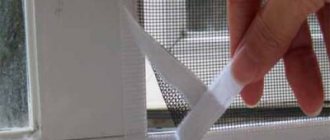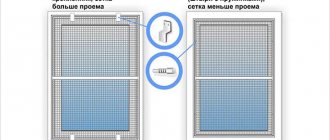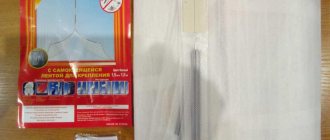With the arrival of warmer weather, hordes of insects come back to life and you can’t live without mosquito nets. Only they are able to protect the premises from the ubiquitous insects. And then some copies manage to leak somewhere. But since the nets are for some reason very short-lived, they have to be replaced or repaired. You won’t call a company representative every time and pay pretty decent money for a job that only takes a couple of tens of minutes. That’s why they try to make/repair/install a mosquito net with their own hands.
Types of mosquito nets
There are three types of mosquito nets:
- Frame. This is a frame made of metal-plastic profile, on which a mesh is stretched. The mesh is attached to the frame using special fasteners: Z-shaped brackets or plungers. This design is the most common, since at a low price it protects well from insects. The cost of producing a mesh is from 500 rubles per square meter.
Frame mosquito net is suitable for both wooden and plastic windows - Rolled. They are designed like roller blinds or blinds. A roll of mesh is attached to the top of the window. By pulling the edge, the net is lowered and fixed. When released from the latch, it rises up. An excellent device, but the price is from 5.5 thousand rubles per square.
Rolled mesh - good, but expensive - Swing nets. The mesh is stretched on the frame, but the frame is reinforced, with a larger cross-section than a frame mosquito net. It is most often installed on doors - balcony or entrance, but can also be installed on windows. It is attached to a door or window block using regular hinges. To prevent it from opening due to gusts of wind, magnets are built into it. The estimated cost of this type of mesh is about 2 thousand rubles. per square.
Hinged mosquito nets are convenient for doors - Sliding. These are meshes specifically for sliding window systems. They also have a frame on which the mesh is stretched. BUT this frame moves along special guides that are screwed on from the outside. This way it is possible to move the mesh to the place where the sash is open.
Sliding - aluminum windows based on the same system - Pleated. The method of action is similar to the roll one, but it is collected not upward, but to the side. There are two guides - top and bottom, along which the mesh that folds into an accordion moves on wheels.
Pleated mosquito net - original and not cheap
As you can see, there are many types. Nevertheless, in 90% of cases frame structures are installed. At a low price, they create a completely normal level of comfort.
Types of fastening frame mesh
Most often, it is frame mosquito nets that are installed. There are two ways to attach them: Z-shaped brackets and rods (plungers).
Different ways to install a mosquito stack
When mounted on brackets, they are mounted on the street side. In most cases, this is convenient and, if circumstances permit, this installation method is chosen. The dimensions of the mesh must be larger than the light clearance of the window sash: the frame is inserted from the outside.
When using plungers, the mesh is also attached behind the glass, but the clamps themselves (rods) are located on the side of the room. This device is convenient on the first floors: it is impossible to remove the mesh from the outside. When installing a mosquito net on rods, its frame must be equal to the size of the light opening. You can’t do it with millimeter precision, but to ensure there is no gap, a brush is attached around the perimeter. It prevents insects from getting in.
View of the installed mosquito net on the rods from the street
How to measure a window for an order
Quite often, a frame with a mesh is ordered from a company, and it is installed on the windows yourself. When ordering, you will be asked to indicate the dimensions of the light opening. The required measurements are taken with the sash open. You measure the distance from one rubber seal to the other: width and height. Measure in several places, write down with millimeter accuracy. The accuracy determines how well the grids will fit your window.
How to measure a window when ordering a mosquito net
Watch how to measure windows to order mosquito stacks in the video.
What you need to know
When ordering or purchasing a mesh for a window, you need to pay attention to its characteristics. Firstly, it is available with different cell sizes: from 0.6 mm to 1.2 mm. The smaller the gap, the less likely it is that an insect will “leak through” and the less fluff there will be. But with high density, air also passes poorly, which can be critical in the southern regions. Therefore, the optimal option is somewhere in the middle 0.8-1.mm.
The mesh is also available from different materials:
- Cotton. Cotton thread has high UV resistance. Its fleecy structure increases the “retention” ability: insects do not crawl through such a mesh. But since the fiber is natural, it reacts poorly to moisture, is often affected by mold and rot, and therefore is rarely used.
- Polyester. The most common material. It is quite strong and durable, although it has a low price, but does not have any special properties.
- Nylon. A special anti-allergenic mesh is made from nylon. It is produced using a special technology with complex weaving. Due to this, it even traps dust and pollen. Such nets are often called “anti-dust” or “anti-allergy”.
- Fiberglass. It is considered optimal because it has high transparency: when using such grids, the degree of illumination almost does not change. At the same time, its strength is very high - even comparable to the strength of metal. An anti-cat mosquito net is made from fiberglass, which can withstand the weight of the animal and does not tear under the claws.
If no special properties are needed, choose the usual one - made of polyester. Sometimes they may ask what color mesh is needed. The most invisible to the eye is gray, so that’s what you can order.
Why you need to remove mosquitoes in the fall
- In snowy weather, snow gets inside the cells. It can turn into frost, which will tear the cells apart.
- Under the weight of snow and ice, the mosquito sag. It won't necessarily damage it, but there is a risk. Strong winds also damage the canvas.
- At low temperatures, handles may crack and break. It will be more difficult to dismantle the structure.
- Birds can damage the mesh; they cling to it with sharp claws and rip it apart.
- Over the summer, a lot of dust will accumulate on it. Leaving the window in this form is simply unsightly, and dirt reduces the shelf life of the product. That is, dismantling is needed to clean the structure and the glass unit.
- Much less light comes through the glass with mesh, but winter time doesn’t offer sunny days anyway.
- Snow and rain contribute to the appearance of rust on the holders.
- If the product is under warranty and damaged by frost or ice, it will not be repaired free of charge. Because the operating conditions have been violated.
As you can see, it is very easy to ruin a product by leaving it on the window. Maybe it won’t tear completely, but the cells will be deformed and insects, fluff, and dust will get into the apartment through them. Therefore, we advise you to still remove the mosquito net in the fall. Use the instructions and video from the article to do it quickly and correctly.
How to install a frame mesh on a plastic window
You have received a ready-made mesh. It comes with 4 small Z-brackets (brackets). Please note that they have shelves of different sizes: two 4 cm each and two 2.5 cm each. Brackets with large shelves are installed at the top of the frame, with smaller ones at the bottom.
Z-shaped brackets have different shelf lengths
To attach to the frame, each support bracket will need 2 self-tapping screws with a screw, which are also called “seeds”. You will need a marker with a thin lead or a soft pencil. You will need a drill with a 2 mm drill bit and a screwdriver or screwdriver.
On the outside of the window frame we draw a strip 3 cm below the edge. We stand on a small stepladder or on a chair, take the frame with the mesh outside the window, and also lean out halfway. Applying the bottom edge of the frame to the drawn line, mark its top.
You can do without manipulating the frame: you need to accurately measure its height and set this value aside from the line drawn below. From the resulting point we put another 1.8 cm up and here we draw a second line. We will use it to align the fastener shelves.
We take brackets with long walls. We apply it so that the protrusion is on the line. You need to retreat about 10 cm from the edges relative to the light clearance. Mark the points where you will need to make holes. We carry out a similar operation with “short” brackets from below. To control, measure the distance between the marks at the top and bottom. It should be 1.8 cm longer than the length of your frame. If everything is correct, drill holes in the profile (2 mm drill) and install brackets on the “seeds”. Actually, that’s all, we can assume that the mosquito net was installed with your own hands.
Installing mosquito nets in a window
Now take the net by the handles, turn it slightly sideways, and take it outside. Insert the upper edge into the upper brackets, align it vertically, lift it all the way, place the edge behind the lower brackets and lower it. The mesh stands supported by brackets.
It is removed in reverse order. Take hold of the handles, lift up until it stops, remove the lower edge from the brackets, moving the mesh a little away from you (a couple of centimeters, no more). Then, moving it down a little, you pull it out of the upper brackets.
Installation on corners
There is another type of fastener, similar in principle to “work” with brackets - corners. When installing this type of clamp for a mosquito net, you also need to accurately measure the width. To do this, you will have to find the center of the light opening, from which to set aside half the width of the grid. The inner part of the corner should correspond to the width of the frame with the mesh with a small gap of 2-3 mm for freedom of fixation.
Corners for installing mesh
That is, if there is this type of fastening, they fix the corners and the width should be exactly at the corners. When installing, we leave the same gap of 1.5-1.8 cm in height. It makes it possible to install the frame in the mounts, and is held in place due to the fact that the upper shelves are larger.
Do-it-yourself mosquito net: we assemble it ourselves
As you understand, you can assemble the frame and stretch the mesh yourself. All components can be purchased from companies that sell spare parts for plastic windows. The following components will be needed:
This is what the frame for a mosquito net looks like in a semi-assembled state
- profile for mesh frame MFP2;
- impost profile (transverse partition with a mesh height of more than 1 m) MFPI and two fastenings for it;
- mesh fabric;
- corners for assembly;
- sealing cord (rubber or even woven);
- handles - 2 pcs;
- self-tapping screws with a countersunk head with a drill, dimensions 3.9*16 mm;
Frame assembly
The frame consists of two long profile sections and two short ones. They are connected to each other using corners. They can be plastic (cheap but short-lived material) and metal, painted with white or brown paint (to match the profile).
They also often install an impost - a jumper, which is installed approximately in the middle of the long side. It increases the rigidity of the structure and prevents long profiles from “playing”.
The lengths of the profiles must be cut taking into account the fact that they are assembled into corners. Therefore, 20 mm is subtracted from the width and length of the light opening (how to measure as described above) - this is exactly the length that is replaced by the corners.
Saw off two sections of the required length from the profiles. It is better to cut with a hand saw for metal - you get a more even cut with almost no burrs. It is brought to smoothness with a file or sandpaper. Then on a flat surface - more conveniently on a table, laying the profile with the grooves up, fold the rectangle, insert the corner holders - the grooves are also up. In the photo, the grooves are directed downwards, but this is inconvenient - you then have to turn the frame over.
We assemble a frame from profile sections and corners
If the corners and profiles match normally, they should be inserted tightly. Very tight. It won't work to put it in place with your hands. You will have to tamp it down, and in order not to damage the plastic, use a lining - a wooden block or a piece of chipboard, as in the photo.
How to assemble a frame for a mosquito net for windows
When assembling, also check the corners. They must be strictly 90°, or the frame will be askew, and there will be cracks into which mosquito flies can crawl. After the rectangle is assembled, we install the impost. We saw it off 2-3 mm shorter than the resulting width of the frame, insert holders on both sides, and secure it to the frame in the groove.
Impost and holder
Stretch the mesh
We spread the mesh over the assembled frame. It should be 3-5 cm larger than the frame on each side: this will make it easier to tighten. We take the cord and press it through the mesh into the groove. You can start from one of the corners, or you can from the middle of the short side, alternately moving to the right and then to the left.
The cord goes in quite rigidly; in workshops it is rolled up with a roller; if it is missing, you can use any object with a rounded surface. The handle of a stationery or kitchen knife, the holder of a screwdriver, the handle of scissors, etc. will do. While straightening the mesh, insert the cord.
Types of handles: plastic and with a metal base
Installation of handles
Having reached the installation site of the impost, we install the handles. Usually they are thin, plastic, inserted into a groove under the mesh, then pressed with a cord. There is a second type of handles - they are denser, sometimes with a metal base, screwed onto the profile with self-tapping screws, but after the mesh has been stretched. If you have a choice, take metal ones or at least plastic ones, but thick ones. The plastic ones are very flimsy and often break.
If during the process the mesh lies crooked, the cord can be pulled out by prying it with a screwdriver or something similar, straightened, and rolled up again. Having finished stretching, check the width and height of the frame at several points. If there are deviations somewhere, it means that the mesh is stretched too tightly in this place. It is loosened by pressing a little with the palm of your hand near the frame. If it is not possible to equalize the width, the cord is hooked and pulled out at some interval. Having equalized the width, holding the mesh, tuck it in again.
You can pry off the sealing cord with a screwdriver
If all the dimensions match, you can cut the cord, tuck in the tail, then walk along the profile again, checking that the seal fits evenly. Now the protruding edges can be trimmed. This is usually done using a stationery knife. That's it, the mosquito net has been assembled with your own hands, you can start installing it on the window.
An example of assembly can be seen in the following video. This is an advertising video: the company sells ready-made kits for self-assembly. The process is not detailed enough, but it can be considered in general terms.
Frequent breakdowns
Failure of the described structures can occur for several reasons:
- Plastic has high strength characteristics and is durable, but over time it breaks and its previous quality indicators are lost. The mesh frame is made of plastic and breaks and deteriorates during use.
- A common cause of failure is sudden temperature changes, direct exposure to direct sunlight in the summer and severe frosts in the winter.
- The cessation of functionality occurs due to the external action of animals and birds that hit the canvas.
In most cases, you cannot do without emergency repair of a mosquito net yourself. Often loss of functionality occurs due to failure of:
- installation handles or plastic corners;
- holders present on the inside and outside
- the fabric is torn directly.
Homemade mosquito nets: saving to the fullest
If you calculate the cost of all spare parts and take into account the time lost on purchasing and assembling them, the benefit is dubious. They still sell components to you at a higher price than to companies. It can only be useful in the sense that after self-assembly you can easily repair it yourself.
However, there are several very inexpensive options for homemade mosquito nets. They are made using a frameless principle and are mounted directly on the window. There are two ways to install this:
- Velcro is a knitted tape that consists of two parts - a tape with hooks and a counter with a rough surface. The mesh is cut out a little larger than the light opening, the counter part is sewn to the mesh, and the part with hooks is attached to the frame around the perimeter of the window with an adhesive layer.
- On the sealing cord. It is inserted in place of the standard seal. To do this, remove it (pry it up and pull it out), stretch the mesh over the opening, and press the cord into the groove. The principle is the same as when installing a mesh in a frame.
For the second way to make a budget mosquito net yourself, watch the video. The idea is great, the costs are minimal.
Installation Tools
It is possible to install a mosquito net yourself on any type of window only if you have certain skills in performing construction and installation work. To do this you will need the following devices and tools:
- drill;
- screwdriver;
- building level;
- pencil for marking;
- fasteners.
It is rational to entrust the installation of the anti-mosquito structure to professionals, especially when it comes to installation at high altitudes. Only in this case can you be completely sure that blood-sucking gnats will not penetrate your living space.
You can purchase fasteners separately in our online store.
